
- Home
- Memories
- Scrapbook ▽
- Topics ▽
- People ▽
- Events
- Photos
- Site Map
- Timeline
Page uppdated 17th December 2012
Also see
The Great 1911 Air Race
Exeter Airport Photo Essay
Exeter Air Day 1977 film
Haldon Aerodrome film (very rare)
A popular departure point for many in the south-west on their European holidays, Exeter Airport, was first conceived by Exeter Corporation, when in January 1932, they started to plan for a city airport. Up until that time Haldon Aerodrome, which was opened by William Parkhouse in 1928, had been Exeter's de facto airport, although it did not provide a regular air service until 1933.
A survey was immediately undertaken to find a suitable site, and after land close to the river was rejected, 180 acres of land belonging to Waterslade Farm to the east of Clyst Honiton was selected. After a public enquiry in 1934, the land was compulsorily purchased the next year at a cost of £10,470. On 1 June 1937, a 21 year lease was signed by Exeter Airport Ltd, a company formed by the Straight Corporation. The rental was £100 per year for the first seven years, £200 annually for the second seven years and £300 per year for the final seven years; a further 2% of the turnover was also to be paid to Exeter Corporation.
The terminus was originally to be constructed in the south west of the site, but it was changed to the south east corner, which increased the cost of running cables and other services. A purpose built terminal building was constructed at a cost of £8,500, while levelling the site and removing trees cost £7,729.
The airport was opened to traffic on 31st May 1937, the day before the lease commenced, although the first aircraft to land was on the 12th May when a Leopard Moth of Air Dispatch Ltd, and piloted by S W A Scott brought a copy of the film of the Coronation of George VI for the local cinemas. The airport was far from complete, and tents were used as the first terminal buildings.
Jersey Airlines immediately inaugurated a summer service of eight flights per week from Jersey in de Havilland DH84 Dragons. Railway Air Services ran connecting flights on to Plymouth and Bristol. The first airliner carrying passengers to land at the airport was on 31 May 1937, when a Jersey Airways DH 86 Express, a four engined aircraft that was the fastest British built airliner in the world, arrived. The flight was met by Mayor Alfred Anstey, who, along with other civic leaders was given a flight over the city. The Great Devon Air Race, sponsored by the Western Morning News, also used the airport on 24 July 1937, when Capt. Phillips in an Avro 504N won on handicap. The RAF 54 Squadron was also present to give an air display.
On 30 July 1938, Sir Kingsley Wood the Air Minister officially opened the new airport, which had, by now, a new, purpose built terminal. Aerobatics by 151 Squadron and by German ace, Herwarth Wendal in a Bucker Jungmeister entertained the crowd, in what was Exeter's first air day. Passenger figures for 1938 were 379.
The airport had always been intended for use by the military in the event of war, and on 3rd September 1939 the airport was taken over by the Air Ministry. Three asphalt runways were laid by John Laing & Sons Ltd, new hangers constructed and the airport extended by demolishing Waterslade Farm. Jersey Airways were employed on evacuation duty on their old route from the Channel Islands during June 1940.
No 213 Squadron was based at Exeter from the 18th June 1940; they were joined by No 87 Squadron on 5th July. RAF Station Exeter became officially operational on 6th July 1940 and soon 87 and 213 Hurricane squadrons were flying out of Exeter to protect the Channel ports.
Although the most westerly of the airfields involved in the Battle of Britain, Exeter was an RAF Fighter Command Sector Station responsible for the airspace west of Portland. Hurricanes from Exeter were heavily engaged in defending the coast during the height of the Battle of Britain during August 1940. Exeter's involvement in the battle was acknowledged by the Luftwaffe when, on the 21st August it suffered its first raid, when four people were killed and twenty-one injured from a single, twin engined bomber.
The Battle of Britain moved further east during September 1940 and life became quieter. No 601 Squadron, known as the millionaires squadron because Max Aitken, son of Lord Beaverbrook and Witney Straight whose Straight Corporation had managed the airport were pilots, moved to the base on the 7th September. At the end of November 87 Sqn. was replaced by the still secret, Westland Whirlwind's of 263 Sqn. For the next two years or so, the airfield was involved in defending the south-west and Exeter from hit and run raids, and the blitz of Plymouth and Exeter. In addition, Exeter squadrons were often called in to defend shipping under attack in the Western Approaches. The Polish night fighter 307 Sqn. flying Defiants, Beaufighters and Mosquitoes was employed from May 1941.
Exeter was also used as the base for sending agents over to France; a curtained limousine would arrive at the far edge of the airfield where the passengers were transferred to a waiting Lysander, which then took off and headed for occupied France. The Lysanders based at two, secret locations, would commence their missions from RAF airfields such as Exeter.
In September 1942, 257 Sqn., flying Typhoons became operational at Exeter, while in 1943, Albacores were employed from 841 Sqn. Fleet Air Arm in anti-shipping patrols. The airport was often used as an emergency landing strip for returning bombers, with landings and crash-landings of B-17s, Lancasters, Wellingtons and other types.
The USAAF used Exeter alongside the RAF, with two squadrons of P-38s in October 1942 for operations over France. In April 1944, the RAF units were withdrawn and the airfield taken over by the US 9th Air Force as Station 463.
On the 18th April the 440th Troop Carrier Group flying seventy C-47As and seventy CG-4 gliders, with other types, arrived in preparation for D-Day. The group comprising the 95th, 96th, 97th and 98th Squadrons had so many aircraft that many had to be parked on the grass as there was insufficient hard standing. The Third Battalion 506th Parachute Infantry Regiment Screaming Eagles arrived in Exeter from Hungerford by train on 27th May and briefing for Operation Neptune, as D-day was coded commenced on 29th May. The battalion was on standby to depart on the 4th June but bad weather in the Channel postponed the operation until the 6th June. On 5th June the US Army Signal Corp photographed troops of the Battalion preparing to embark, each man loaded down with kit that weighed as much as himself. At 22.30 the battalionenplaned and the first aircraft took off at 23.20.
After take off, the four squadrons, totalling 45 aircraft, and codenamed Serial 10 carrying 723 men and 2 platoons from C/326th Airborne Engineers also of the 101st Airborne headed for the assembly area at Portland, in poor weather, before joining aircraft from other southern airfields for the journey across the Channel. The unit lost three C-47s dropping the paratroopers over Carentan in the early morning of the 6th June. On the next day they continued flying parapacks, fuel and ammunition to the landing area of Normandy, losing two more aircraft, for which they received the Distinguished Unit Commendation. They lost a third aircraft that day, when it was hit by a stray bomb from a higher flying P47 Thunderbolt.
The unit moved to Rheims in France in September and the RAF returned to Exeter, but in smaller numbers than formerly. As the Allies fought their way across France and Belgium to the German border, the need for defensive units lessoned and the airport transferred to 23 Group of Training Command in January 1945. No 3 Glider Training School relocated to Exeter where glider-tugs and gliders also used Culmhead airfield as a landing ground.
After the cessation of hostilities in Europe, in May 1945, a succession of RAF squadrons arrived and departed the airfield. By November 1945, 691 Sqn. were engaged in anti-aircraft work, the first of many years involvement in anti-aircraft activities for Exeter. In June 1946, the airport saw its first jet aircraft arrive with 222 Sqn., and in only a months stay they managed to lose one aircraft, a Meteor in a crash near Powderham.
Exeter Airport was handed over to the Ministry of Civil Aviation in January 1946 , while the RAF finally left in October 1946, although 84 Gliding School continued to train ATC Cadets for many more years.
The airport started to attract engineering and other facilities associated with flying, and in February 1948, the small aircraft manufacturing company, Chrislea rolled out the first of seventeen Super Ace and Skyjeep variants. Development of the unconventional aircraft was initially at Heston, but production switched to Exeter in 1946. Production of this small, single engined aircraft continued up to 1952. The Harper Aircraft Company took over Chrislea which evolved into the Exeter Aircraft Company making parts for Vickers Armstrong Viscounts, VC10s and other marques.
The expertise of Exeter based aeronautical companies started with the repair of Spitfires in the workshops of Pike's Garage during the war based where the Riverside Leisure Centre can now be found. In 1988, these skills were still evident when Westcountry Aircraft Servicing overhauled the last flying Lancaster bomber, which was part of the Battle of Britain Memorial flight.
The Exeter Aero Club also returned in June 1947 to a still camouflaged airfield, and commenced offering Private Pilot and Flying Instructor courses. A private pilot licence holder could hire the club's Auster or Tiger Moth for £3 per hour and a trial lesson for an aspiring pilot was £1 5s (£1.25).
This unit often referred to as the CAACU was formed in March 1951 for target towing, testing and instrument calibration for the RAF, Army and Navy. They operated many famous aircraft types from the war such as Spitfires, Mosquitos, Beaufighters, and Ansons as well as postwar types such as Vampires, Meteors and from 1960, Hawker Hunters.
In its twenty years existence, the unit flew over 75,000 hours and provided aircraft for use in films such as Reach for the Sky with Kenneth More in 1956 and 633 Squadron in 1964. In Reach for the Sky, the units Spitfires were given false RAF markings painted on them to cover the CAACU markings; water based paint was used, and every time it rained, the markings were washed off, requiring them to be repainted for the next sequence. A Spitfire used in the film is preserved at Auckland War Museum and a Mosquito from 633 Squadron can be seen at Hendon Museum.
It was not until 1952 that Jersey Airlines started the first post-war scheduled service, to the Channel Islands; this was not the same company that operated pre-war. On the 7th April, a by now, dated deHavilland Rapide landed, to be met by a party of local dignitaries, who entertained the eminent passengers to lunch to inaugurate the new service.
In 1954, the airline took delivery of its first de Havilland Heron which could take 14 to 17 passengers and, for the first time, an airhostess. Jersey Airlines were eventually taken over by British United Airways in 1962.
Other airlines have been formed and operated at Exeter over the years. Some have lasted a year or two, others have been quickly taken over by a larger rival. In 1961, British Westpoint Airlines was formed by the Mann family who went on to take over the Mayflower Air Service from Plymouth, operating routes to the Scilly Isles, Newquay Plymouth and Gatwick, only to cease operations in May 1966. Routes were extended by Jersey Airlines and later British United to Paris, Dublin, Cork and Belfast. The first Liverpool, Exeter, St Mawgan service in Dakotas piloted by Captain Tickle of Starways Airways operated in 1959.
After the war, the airport remained in Government ownership. In 1972, a consortium of Devon County Council, Exeter City Council and Torbay Council purchased the airport. In 1974, local government reorganisation saw Devon County Council take full responsibility, with the airport managed under contract by Exeter Airport Ltd.
Air UK was formed in 1980 from the amalgamation of several smaller airlines and routes to Ireland, the Channel Islands, France, Holland, Glasgow and Gatwick introduced.
In 1978 the main runway was strengthened to take heavier aircraft, followed in 1981 when an improvement program for the terminal buildings and a more modern air traffic control and instrument landing system was installed. In 1985, Jersey European Airways moved its operations from the Channel Islands to Exeter; this airline would evolve into Flybe, the main airline to be based at Exeter. Currently, the airline has four maintenance hangers at the airport for its fleet.
On the 50th Anniversary of Exeter Airport in 1988, Concorde arrived for the first of a series of annual visits to take passengers for a flight over the Bay of Biscay.
In 1997, Britannia Airways launched a service to Florida and a year later, services to Menorca, Gran Canaria, Lanzarote and the Dominicam Republic were introduced, followed in 2007, when First Choice established a permanent base at the airport.
By 1998 the airport was handling 250,000 passengers a year and in December, Devon County Council, who had owned the airport from 1974, announced that they were considering selling the airport as they thought they could not afford the further development required to take the airport into the new century.
In 1998, the sixtieth anniversary of the opening, a new terminal buildings was inaugurated.
After an abortive attempt in 2005 to sell at least 75% of its holding in the airport, Devon County Council sold Exeter International Airport to the Regional and City Airports (Exeter) Ltd, which is owned by Balfour Beatty for £60 million in January 2007.
In 2008, the South West Airfield Heritage Trust planned a larger than life, bronze sculpture of RAF fighter pilots from World War Two to be displayed outside the main terminal.
Source: Airfield Focus by Jerry Brewer, Exeter Airport in Peace and War by Geoff Worall, Exeter Airport website history, Wikipedia, Devon Aerodromes in Old Photographs by Keith A Saunders and the Express and Echo.
View Larger Map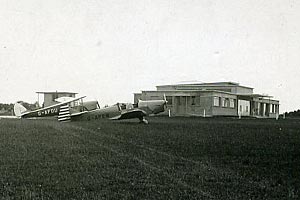 Terminal
building in 1938.
Terminal
building in 1938.
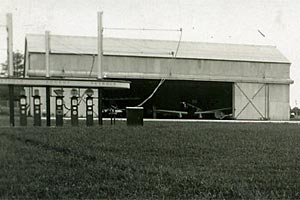 Hangar and fuel pumps in
1938.
Hangar and fuel pumps in
1938.
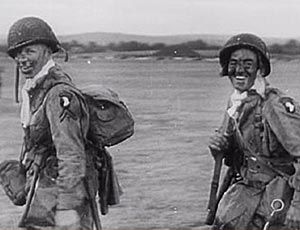 Two paratroopers of the
US 101st
Airborne Division embarking for D-day
from Exeter.
Two paratroopers of the
US 101st
Airborne Division embarking for D-day
from Exeter. 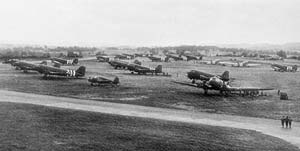 C47s of 440th Troop Carrier
Group before D-Day.
C47s of 440th Troop Carrier
Group before D-Day.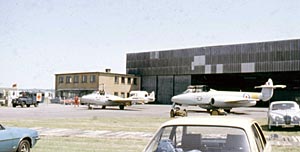 A Meteor and a Vampire
parked up at
Exeter Air Day 1977. Photo Alan H
A Meteor and a Vampire
parked up at
Exeter Air Day 1977. Photo Alan H
│ Top of Page │